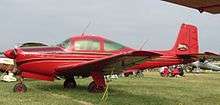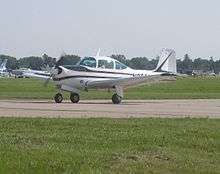Meyers 200
| Meyers 200 | |
|---|---|
 | |
| A 1966-built Aero Commander 200D | |
| Role | |
| National origin | United States of America |
| Manufacturer | Meyers Aircraft Company |
| Introduction | 1955 |
| Unit cost |
$12,500 less radios in 1960 |
The Meyers 200 was a single-engined light aircraft produced in the United States in the 1950s and 1960s.
Design
It was the brainchild of Al Meyers and was a development of his Meyers MAC-145 design. The holder of a number of speed records in its class, the Meyers 200 is widely admired for its clean lines, and is also known for its exceptionally sturdy airframe. This strength is derived from a tubular 4130 chrome-moly steel truss structure with aluminum skin that protects occupants.[1]
Acquisition by Aero Commander
In 1966, the Aero Commander division of North American Rockwell purchased the rights to the Meyers 145 and 200, as part of a strategy to capture a share of the light aircraft market in the United States. During this time it was in the James Bond film You Only Live Twice. Known briefly as the Aero Commander 200, it soon emerged that the firm could not produce the design economically. Meyers' firm had been virtually hand-building each aircraft and no jigs or tooling for the kind of mass production envisaged by Aero Commander even existed at the time the rights were bought. Having spent US$4 million to produce just US$3 million worth of product, Aero Commander ceased production in 1968 and sold the rights to the Interceptor Corporation, which developed a turboprop-powered version as the Interceptor 400. Ownership of the rights eventually passed to Prop-Jets, Inc., now known as Interceptor Aircraft Corporation.
Operational service
The Meyers 200D has never had an in-flight structural failure and has never had an FAA mandated Airworthiness Directive (AD) issued against the airframe. The 4130 chrome-moly steel tubular roll cage and understructure act like a race car protective cage during a crash. Several Meyers aircraft have been forced down in the trees and off airport runways with documented instances of the occupants walking away with only minor injuries or a broken bone.
Variants
Meyers

- 200 — single prototype powered by Continental O-470
- 200A — production version powered by Continental IO-470 (11 built)
- 200B — (17 built)
- 200C — raised roof-line and larger windshield (9 built)
- 200D — engine replaced with Continental IO-520A and flush riveted wings (8 built)
Aero Commander

- 200 — Aero Commander version of the 200D (77 built)
- 200 — Aero Commander version of the 200E (1 prototype built)
- T200E — experimental twin-engine conversion - never built
Interceptor
Specifications (Meyers 200D)
General characteristics
- Crew: one pilot
- Capacity: 3 passengers
- Length: 24 ft 4 in (7.42 m)
- Wingspan: 30 ft 6 in (9.30 m)
- Height: 7 ft 4 in (2.24 m)
- Wing area: 162 ft² (15.0 m²)
- Empty: 1,940 lb (882 kg)
- Loaded: 3,000 lb (1,364 kg)
- Maximum takeoff: 3,000 lb (1,364 kg)
- Powerplant: 1x Continental IO-520A, 285 hp (209 kW)
Performance
- Maximum speed: 239 mph (385 km/h)
- Range: 1,200 miles (1,931 km)
- Service ceiling: 18,500 ft (5,640 m)
- Rate of climb: 1,350 ft/min (412 m/min)
- Wing loading: 18.5 lb/ft² ( kg/m²)
- Power/Mass: 10.5 lb/hp ( kg/kW)
See also
Related development:
Comparable aircraft:
References
External links
| Wikimedia Commons has media related to Meyers 200. |